BABY’S PINK THUMBS.
The snow had quite covered
the ground,
The wind whistled
fiercely and chill,
When a poor little storm-beaten
bird
Flew down on the
broad window-sill.
Within, there was comfort
and wealth;
Gay pictures half
covered the wall;
The children were happy at
play;
And the fire shone
bright over all.
Without, there was famine
and frost;
Not a morsel of
fruit or of grain;
And the bird gave a piteous
chirp,
And tapped with
his beak at the pane.
Then baby climbed up on a
chair,
Forgetting his
trumpets and drums:
He doubled his two little
fists,
And pointed with
both his pink thumbs.
“See, see!” and
he laughed with delight,
“Pretty
bird, pretty bird: here he comes!”
When the bird, with a bob
of his head,
Made a peck at
the baby’s pink thumbs.
Then the children called out
with great glee,
“He thinks
they are cherries, or plums,
Or pieces of apple; and so
He tries to eat
baby’s pink thumbs.”
“Poor birdie!”
said mamma: “we know
That God for his
creatures will care;
But he gives to his thoughtfuller
ones
The pleasure of
doing their share.
“We softly will open
the sash,
And scatter a
handful of crumbs;
And, when birdie wants breakfast
again,
He needn’t
peck baby’s pink thumbs.
“He may come day by
day, if he will,
To a feast on
the broad window-ledge,
And fly, when he’s eaten
his fill,
To his home in
the evergreen hedge.”
OLIVE A. WADSWORTH.
ABOUT FLAX, BARLEY, AND RYE.
Arthur had been looking at some pictures in a book; but he did not quite understand what they were: so he called on Uncle Oscar to explain.
Uncle Oscar took him on his knee, and said, “This, Arthur, is a picture of the flax-plant, a very useful plant indeed; for from it we make linen. Your apron is linen: so are the collar and wristbands on my shirt.
“The flax-plant bears delicate blue flowers, which look very pretty when in bloom. Flax is raised very largely in Kentucky, and other States in the Union. Do you know what part of the plant is the stalk? I will point it out to you in the picture.
[Illustration: FLAX.]
“Well, from this stalk the thread, or fibres, are got, out of which linen cloth is made. The flax is pulled a little before the seeds are ripe: it is stripped, and the stalks are soaked in water. The flax is then dried, and broken and beaten till the threads, or fibres, of the bark are fit for spinning. From the seeds, linseed-oil is made.
“Is it not strange, Arthur, that out of the stalk of this little plant should be made the nice white linen of your apron and my handkerchief?”




